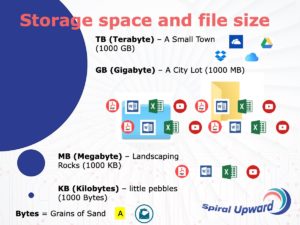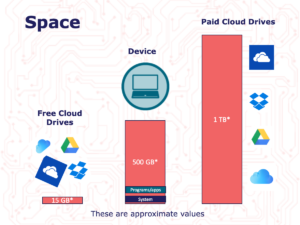Do You Have Enough Digital Space?
Space is such a relative thing and digital space is often difficult to understand because we can’t actually see it or feel it, but at least the math is easier than it is with baking and furniture arranging.
So how do you know how much “space” you have? And if you really need more.
The definition of space
In the digital size situation, the smallest reasonable size is 1 Byte. A Byte is like a grain of sand. It takes 1000 Bytes to make 1 Kilobyte (KB).
The first useful size is the KB (Kilobyte). When you look at the files on your computer you will see a lot of files with a number and KB. PDF’s, basic Word documents, spreadsheets, and some images can all land in the KB size. If these files become complex enough they can enter MB (Megabyte) status.
It takes 1000 KB (Kilobytes) to make one MB (Megabyte).
1000 Bytes = 1 KB (Kilobytes)
1000 KB = 1 MB (Megabyte)
This is all nice to know, except your computer and your cloud drives are all measured in GBs and TBs, so you need to know how to translate that into something useful.

As you become more familiar with the relationships between the different sizing words it is easy to determine your space situation.
Here is the chart that matters.
1000 Bytes = 1 KB (Kilobytes) – a little pebble
1000 KB = 1 MB (Megabyte) – a heavy landscape rock
1000 MB = 1 GB (Gigabyte) – A city lot
1000 GB = 1 TB (Terabyte) – a town
As far as types files in your computer, you are likely to find that video files take up the most file space, then images, then documents (PDF’s and Spreadsheets are in the category), then text files and emails. There are exceptions, but that’s true with anything.
If it helps you can think of digital space like real space on the earth.
Bytes are like grains of sand
Kilobytes are like pebbles
Megabytes are like rocks
Gigabytes are like yards
And Terabytes are like cities.
All of these digital files are made out of the same stuff, but they grow as they become more complex.
How much “space” do you have?
You don’t have unlimited space. Your computer’s hard drive can only hold so much digital data and your Cloud Drive gives you only so much digital space based on how much you pay.
To access your space situation the first thing you want to check is your computer, that way, you know where to start.
You can see how much space you are using and how much space you have by checking your hard drive properties.
Your computer space
PC
- Using the Windows Search feature, search for “Storage”
- Click on your PC’s C: Drive
MAC
- Click the “apple” in the upper left corner.
- Choose “About this MAC”
- Click “Storage”
- Click “Manage” for more details.
You will be able to see how much space is taken up by the “system”. The system is the program that runs your computer, which means, you can’t do much about how much space it takes up.
The other information identifies how much space is used by programs or applications you can uninstall if needed.
The rest is space for pictures, documents, and other files.
Your cloud space
Next, you will want to check your cloud drive.
Cloud drives like Dropbox, Google Drive, and OneDrive also have ways to check your plan’s space needs. Here are some typical numbers

Google Drive – Login to your drive online and look to the lower left corner.
FREE is about 15 GB
Paid gets you 1 TB
OneDrive – Login to your drive online and look to the lower left corner.
FREE is about 5 GB
Purchasing Office 365 gets you 1 TB
DropBox – Login to your drive online and go to “settings” and choose your “plan”
FREE is between 3 and 15 GB
Paid gets you 1 TB
What you need to know about using digital space
As you think about your space needs there are a few things to consider.
When you sync your computer to your cloud drive, the files on your cloud drive will take up space in The Cloud and on Your Computer, this is why you can still edit and create when your computer is offline. You have essentially 2 copies of the file. They are linked and will update if changed in either direction. This is really the true purpose of using a cloud drive.
Because your cloud drive and your computer’s hard drive are often not the same sizes you need to be aware of how much space you are using in each. You can also control which files are being shared between the drives. Sometimes you will have files that you only want in the cloud and sometimes files only on your computer hard drive and not in the cloud.
Back in the day, we could consider our computers to be the main hub of our information. Now, however, the cloud drive is your hub. All your devices, including your computer, should be connected to the cloud drive so the synchronization between everything can happen smoothly.
A necessary solution for enough digital space
One last hard truth. It is really a good idea to pay for storage in the cloud. Managing the limited digital space allowable between the free offerings of most cloud services tends to be more troublesome and time-consuming than it is worth. (although, it can be done)
Digital Detangle: Managing Digital Space
Join me in this Digital Detangle as I talk about, and demonstrate strategies you can use to manage your digital space.
And remember, if you are stuck or these strategies don’t work for your situation you can always schedule a topic tackle with me and we can conquer it together.
- Schedule a Topic Tackle and let's get it started!
Be sure to ask how you can get UNLIMITED Topic Tackles
“Don’t let your technology bully you!”

Nicole Lux-Ritchie - Founder of Luxcentric
Nicole's mission is to help feminine professionals gain the technical
skills they need to grow their business and focus on their missions.
The focus of Luxcentric is on training practical strategies in the area of the core technologies.
EMAIL - FILES - CALENDARS - CONTACTS
For those of you who find this information useful and would like to contribute to the cause (and keep it ad free)...


